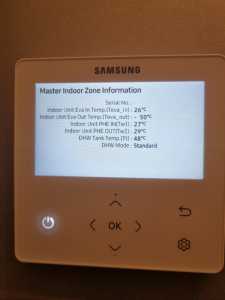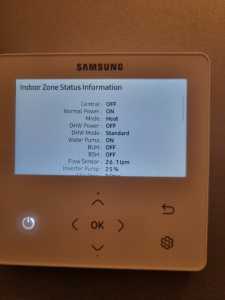Samsung 12kw efficient running. The little tweaks.
Thought I'd start another topic and sorry if it seems like the Craig has a question forum. 🤣🙈
I struggled to find answers to these questions specific to the Samsung system. I also googled and there is so much conflicting advice. Even across two stories on this site about room stats and trv's.
Now I seem to have my Samsung 12kw gen 6 running on WC (Water law) and no longer short cycling, I am , like many others looking to get those little efficiency gains. So I have a few questions.
I like a cold bedroom so I have shut off that rad completely, is that okay or will it run less efficiently?
Should I turn the system down at night? I haven't found a way to do this yet? I've found "Quiet mode" is it okay to use that?
Where can I find my return water temp? Flow temp is on home screen as "water outlet". I want to check there is enough of a difference. Is that called delta T?
Whilst trying to sort my other issues I had these screens up, do these show the info I need under another name?
Thanks in advance and sorry again for so many questions. I've been through the manuals and they just fry my brain but I feel I want to really understand this system.
The value on the screen labelled 'Indoor Unit PHE OUT(Tw2)' is the temperature of the water coming from the heat pump, and you've guessed it, the value labelled 'Indoor Unit PHE IN(Tw1) is the temperature of the water being returned to the heat pump.
The PHE is the Plate Heat Exchanger located in the outdoor unit that transfers the heat energy from the refrigerant gas to the water.
Thanks again Derek. So these are what is referred to as Flow and return temps? Should they be that close? Will it affect efficiency if they are?
As long as you don't close off too much of the system you can safely turn down a bedroom TRV. If you shut down too many you'll reduce demand and you may get cycling returning.
In my system you can't adjust weather compensation at night on a timer. I therefore just use the timer to turn the heating off from 12-5am. The house slowly cools and warms up again in the morning by the time I'm up and about Contrary to what some say, this does use less energy than leaving it on. There is a spike when it kicks in in the morning but it doesn't last long.
Posted by: @craig1980Thanks again Derek. So these are what is referred to as Flow and return temps? Should they be that close? Will it affect efficiency if they are?
A difference of 5C is normally maintained between the flow and return temperatures, which is usually done by raising or lowering the speed of the water pump. Because your system does not have a PWM enabled pump, it cannot do this automatically. You could try manually setting the pump to a lower speed setting and see what happens.
@kev-m yeah, I don't have a programmable temp set back either but quiet mode runs at less power. I can't really find any information on it though other than a video of the older Samsung and that it shouldn't be used as it causes defrost cycles.
I might try the timer on the room stat, I think it has one. Thanks.
@grahamh I know you were very heavily involved with getting the Samsung units popularised over here, could you shed some technical light (for the engineers amongst us) on why only Midsummer Wholesale are the only people using the PWM output from the MIM to provide speed control of the primary circulation pump?
I forget which one of your training videos I’ve seen but on one of them you mention ‘ignore this cable, we won’t use this on production units’ when referring to the PWM output.
Off grid on the isle of purbeck
2.4kW solar, 15kWh Seplos Mason, Outback power systems 3kW inverter/charger, solid fuel heating with air/air for shoulder months, 10 acres of heathland/woods.
My wife’s house: 1946 3 bed end of terrace in Somerset, ASHP with rads + UFH, triple glazed, retrofit IWI in troublesome rooms, small rear extension.
Posted by: @craig1980@kev-m yeah, I don't have a programmable temp set back either but quiet mode runs at less power. I can't really find any information on it though other than a video of the older Samsung and that it shouldn't be used as it causes defrost cycles.
I might try the timer on the room stat, I think it has one. Thanks.
You could manually lower the LWT by using the WL offset, but of course it would require someone to raise it again in the morning.
Posted by: @craig1980@derek-m thanks again. I assume that is done with the button on the pump itself? I also assume that I should adjust both to the same?
There will be a button on the pump for adjusting the speed. I'm not 100% certain how your system is piped up, so try adjusting one pump speed first, then adjust the second pump if you think it is necessary.
Note the temperatures around the system before and after making any adjustments.
@derek-m yeah, I'd realised that. Unfortunately my bladder is strong enough to last through the night so I don't need to get up in the early hours yet. 🤣
I'm assuming you mean flow and return temps not rad temps?
Posted by: @craig1980@derek-m yeah, I'd realised that. Unfortunately my bladder is strong enough to last through the night so I don't need to get up in the early hours yet. 🤣
I'm assuming you mean flow and return temps not rad temps?
When I am testing systems I initially take readings at many points, then reduce the number of points once I discover which are important and which are not. You could measure the temperature on two or three radiators around your home.
The more important temperatures are of course the flow are return.
- 26 Forums
- 2,417 Topics
- 54.8 K Posts
- 254 Online
- 6,096 Members
Join Us!
Worth Watching
Latest Posts
-
RE: Octopus Cosy 12 Heat Pump Regret: Incredibly Loud, Poor Heating & Constant Hum - Help!
So, after much anguish, and even visiting the neighbour...
By razz , 3 hours ago
-
MLCP (Multi-Layer Composite Pipe) for ASHP
@editor nope. The info you reported was sufficient for ...
By iotum , 5 hours ago
-
RE: Advice for a novice on Mitsubishi Ecodan 6kW
@robs Quick response while I'm in stationary traffic le...
By Sheriff Fatman , 5 hours ago
-
RE: Setback savings - fact or fiction?
Maths looks right to me, my only question about this ca...
By JamesPa , 6 hours ago
-
RE: Ideal HP290 14kW ASHP - how to optimise
@jamespa I wasn’t offended at all. You are very knowled...
By Davesoa , 6 hours ago
-
RE: Experience - New Build / Complete New Heating System
@vincro I would be surprised if it is much above 5 to 6...
By ASHP-BOBBA , 6 hours ago
-
RE: Recommended home battery inverters + regulatory matters - help requested
Yes, certainly not enough could have been tested in any...
By Batpred , 7 hours ago
-
RE: Post-Traumatic Heat Pump Stress Disorder
Yes bang on and maybe I can illustrate that by way of e...
By iotum , 8 hours ago
-
-

RE: Replacing my 18 month old Hitachi Yutaki ASHP
A big thank you to @jamespa for all his efforts online ...
By trebor12345 , 11 hours ago
-

RE: GSHP WOES! Midland based engineer recommendations?
@editor It is indeed for servicing. My current service ...
By Morgan , 12 hours ago
-
RE: Sunsynk Whole House Backup Issue
Hi @lostandconfused , I agree that topic/thread is the ...
By Batpred , 12 hours ago
-
RE: Speedcomfort radiator fans
In case it helps Andrew Kuhne on openenergy monitor has...
By JamesPa , 13 hours ago
-

Things have gone quiet with you @drei. Any updates?
By Mars , 16 hours ago
-

RE: Passiv Smart Thermostat - Help & Forum Support
Thanks @tim441. Interesting timing, as Passiv are a cur...
By Mars , 18 hours ago
-
Hi everyone, I have a two year old Marlec Solar iBoos...
By Tallmarc , 20 hours ago
-
RE: Please help with the settings ecodan
Are you trying to address any particular performance is...
By Sheriff Fatman , 1 day ago
-
RE: Solis inverters S6-EH1P: pros and cons and battery options
🤣 Well, I never managed to get the HA solis "...
By Batpred , 1 day ago







